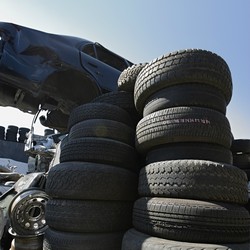Microwave pyrolysis for tyre recycling
With the growing number of vehicles, the disposal of end-of-life tyres (ELTs) is a growing problem. They are often dumped or landfilled, posing a serious environmental issue. But, the technology to recover high-value materials from waste tyres is moving forward. Researchers have developed a complete process to convert waste rubber crumb into valuable materials with EU funds of the project SULFREE(opens in new window) (Tyre recycling pyrolysis for producing oil with less than 0.2% sulphur content, low cost sulphur impregnated carbon for reducing mercury air emissions, with simultaneous elemental). The process begins with microwave pyrolysis. As there were no ELT microwave pyrolysis plants in operation, this was a major achievement. An innovative internal mixing system of discs and rods thoroughly mixes the rubber crumb to achieve complete pyrolysis. Carbon black and hot gas, the products of pyrolysis, are both high in sulphur content. The carbon black is activated with steam to increase its commercial value. The hot vapour is cooled, compressed and injected under pressure into a fixed-bed reactor to yield ultralow-sulphur oil, ultralow-sulphur gas and sulphur. A condensing system that produces condensed sulphur-rich oils instead of vapour reduces the cost of the process significantly. The shell-and-tube-type heat exchanger of the condenser facilitates heat and steam recovery to satisfy energy requirements and to activate the carbon black. Scientists demonstrated the cost effectiveness of the system. Recovery rates were comparable to current schemes (over 90 %), with the important difference that the products are high-value pyrolysis oil, sulphur-impregnated activated carbon, elemental sulfur and combustion gases. The SULFREE technology is expected to have important economic benefits for the small and medium-sized enterprises active in the field, increasing their business opportunities and profitability. Encouraging tyre recycling will also minimise illegal landfill waste.







